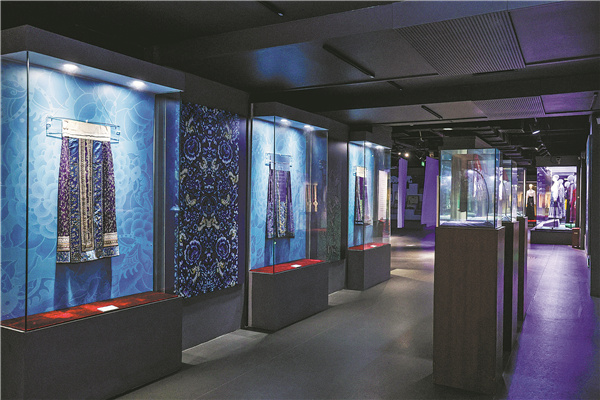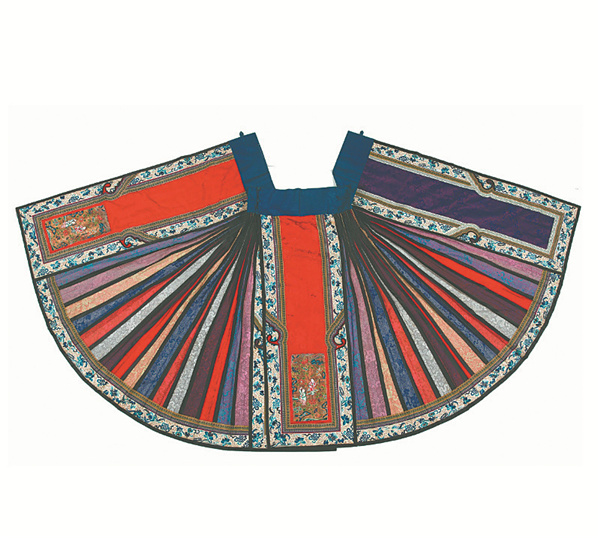Traditional Chinese garment makes stylish comeback

The Shanghai Textiles Museum's ongoing exhibition Splendid Mamianqun. [Photo provided to China Daily]
Mamianqun becomes trendy among younger generations as modern iterations reflect self-expression, Wang Xin reports.
The mamianqun, translated as the "horse-face skirt", is a type of traditional clothing that is making a comeback as the latest fashion trend, gaining increasing popularity among younger Chinese generations, according to those in the know.
The curators of an ongoing exhibition, Splendid Mamianqun, at the Shanghai Textiles Museum, made the above observation, due to the emerging trend of young people's growing sense of cultural pride.
Mamianqun is a type of hanfu that features a high, flat front and pleated sides. It originated in the Song Dynasty (960-1279) and maintained its popularity during the Ming and Qing dynasties (1368-1911).
Launched on May 18, the two-month exhibition showcases dozens of mamianqun, including over 40 pieces from the ancient dynasties and 12 modified skirts with innovative designs. The exhibition has attracted a large number of visitors, many of which came dressed in mamianqun — both males and females, says Jia Yiliang, curator of the Shanghai Textiles Museum and a curator of the exhibition.
"There is an old saying — 'You are what you wear'. Mamianqun embodies the aesthetic, philosophy and wisdom of ancient Chinese dressmakers, reflecting the status, thoughts and experiences of the people wearing them," Jia says.
"Mamianqun, as a type of clothing, is also a language of self-expression and is close to our daily lives. You can either admire them from a professional perspective for the craftsmanship, technique and philosophy, or simply from a personal view and preference."
Despite the long history of mamianqun, it was not until recent years that this traditional garment drew extensive focus, gaining international attention on the ancient Chinese skirt.
Ma Wenjuan, one of the curators of the exhibition and deputy director of the Journal Center at Donghua University, was among the first to introduce in details the skirt to more people in 2022.

A mamianqun from the Qing Dynasty (1644-1911) features phoenix as the ornament. [Photo provided to China Daily]
Along with some notable professors, Ma published a post to explain the features of mamianqun and its origin in China.
Yet, Ma found one single post far from enough to make the public understand mamianqun.
Working together with authors, Donghua University Press published a book on May 17 to comprehensively explain the traditional Chinese clothing, including its history, colors, patterns, techniques and cultural connotations.
"Mamianqun is one of the most influential and widely worn traditional Chinese clothing in the recent guofeng — Chinese style using elements from traditional culture — boom. Its popularity not only leads the new Chinese fashion trends but also witnesses the rising cultural confidence of Chinese people," says Jia Xizeng, one of the curators of the exhibition and an author of the book.
He notes that the mamianqun design, structure, pattern and cultural connotations have formed the coexistence of its sporty, decorative and ceremonial features, representing the wisdom and aesthetic of ancient Chinese dressmaking.
Such features have also made mamianqun a versatile garment suited for both everyday wear and ceremonious occasions.
Seamlessly integrating tradition and modernity, an increasing number of young people in China are choosing it for their mix-and-match daily outfits.
According to a report on female consumption trends by Douyin e-commerce, over the past year, the platform's orders for new Chinese-style clothing increased by 195 percent year-on-year. Orders for hanfu surged by 336 percent year-on-year, with orders for mamianqun rocketing by 841 percent year-on-year.
Jia Yiliang also notes that she has seen the growing popularity of mamianqun and hanfu among males.
"In addition to young female visitors, we are pleased to see many males and elderly at the exhibition. They are yearning for traditional Chinese clothing as well. Unlike other traditional Chinese garments, such as qipao, mamianqun usually relies less on gender or body shape and is easier to wear."

A painting from the Ming Dynasty (1368-1644) features people in the royal palace dressed in mamianqun. [Photo provided to China Daily]

Another, featuring figures and courtyards, also from the Qing Dynasty. [Photo provided to China Daily]
"Although people's lifestyles and dress habits have changed dramatically with the development of society, the mamianqun still exudes a unique charm. It is not only loved by traditional dress enthusiasts but also valued and sought after by Western fashion brands and designers," Jia Xizeng adds.
At the exhibition, several relic mamianqun, as well as new designs by Lin Xi, are on display.
As an inheritor of the craftsmanship for making mamianqun and the founder of a clothing brand, Lin has been making efforts to bring this traditional Chinese garment to the global stage with her modern modifications. Notably, Lin launched a show featuring mamianqun during the Paris Fashion Week last September.
"Clothing is a premier bridge for cultural exchanges," says Jia Yiliang, highlighting a donated piece of mamianqun on display. At the request of an American in China back in the Qing Dynasty, the garment was remodeled from the traditional Chinese skirt, brought to the United States, kept generation to generation, and finally found its way back home to the Shanghai Textiles Museum.
Witnessing the success of the exhibition, both Ma and Jia Yiliang are confident and ready for their plans to dig deeper into this sector.
"Through mamianqun, we expect to draw more attention to the clothing and traditional Chinese culture. We will continue to work to promote the culture to a wider audience, and I believe more young people will join us," says Ma firmly.
If You Go
Splendid Mamianqun
Through to July 18
F3, Shanghai Textiles Museum, 150 Aomen Road, Putuo district, Shanghai
Related articles
-
 Highlights of "Snow Lotus-Fang Ying Haute Couture" fashion show at CIFTIS
Highlights of "Snow Lotus-Fang Ying Haute Couture" fashion show at CIFTISMore
-
 Qingxian county's makeup brush business facing bright future
Qingxian county's makeup brush business facing bright futureMore
-
 Fashion show held on sidelines of Xinjiang int'l dance festival
Fashion show held on sidelines of Xinjiang int'l dance festivalMore
-
 Long apprenticeship leads to lasting career
Long apprenticeship leads to lasting careerMore
-
 The rise of China's domestic cosmetic brands
The rise of China's domestic cosmetic brandsMore
-
 Spring/Summer 2024 Men's collection of Dior Homme
Spring/Summer 2024 Men's collection of Dior HommeMore
